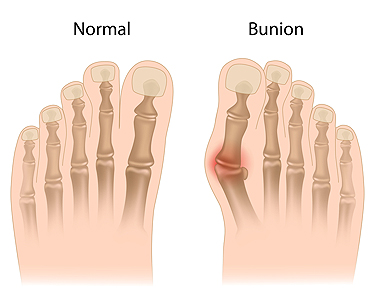
A bunion is an unsightly and often painful deformity of the big toe, termed hallux valgus. This deformity starts in the bottom joint of the big toe, causing the bone to jut out sideways and push the top part of the toe toward the second toe. This can result not only in foot alignment issues but also problems with gait and weight bearing. A bunion is often very painful as the misshapen big toe rubs against the inside of the shoe and places more pressure on the ball of the foot. The major cause of bunions is believed to be genetic, but ill-fitting footwear and high-heeled shoes are other possible causes. In some cases, a bunion may be caused by rheumatoid arthritis. The first and simplest way of dealing with a bunion is changing footwear to accommodate the width of the foot and provide more cushioning. Bunion pads and toe spacers also may relieve some of the pain and pressure. In the worst cases, some form of surgery is an option to correct the deformity. The type of operation will be based on the severity of the bunion, along with other factors. For more information on treating a bunion, it is suggested that you make an appointment with a podiatrist.
If you are suffering from bunions, contact one of our podiatrists of Bruening Foot & Ankle. Our doctors can provide the care you need to keep you pain-free and on your feet.
What Is a Bunion?
A bunion is formed of swollen tissue or an enlargement of boney growth, usually located at the base joint of the toe that connects to the foot. The swelling occurs due to the bones in the big toe shifting inward, which impacts the other toes of the foot. This causes the area around the base of the big toe to become inflamed and painful.
Why Do Bunions Form?
Genetics – Susceptibility to bunions are often hereditary
Stress on the feet – Poorly fitted and uncomfortable footwear that places stress on feet, such as heels, can worsen existing bunions
How Are Bunions Diagnosed?
Doctors often perform two tests – blood tests and x-rays – when trying to diagnose bunions, especially in the early stages of development. Blood tests help determine if the foot pain is being caused by something else, such as arthritis, while x-rays provide a clear picture of your bone structure to your doctor.
How Are Bunions Treated?
- Refrain from wearing heels or similar shoes that cause discomfort
- Select wider shoes that can provide more comfort and reduce pain
- Anti-inflammatory and pain management drugs
- Orthotics or foot inserts
- Surgery
If you have any questions, please feel free to contact our offices located in Covina and Alta Loma, CA . We offer the newest diagnostic and treatment technologies for all your foot care needs.
